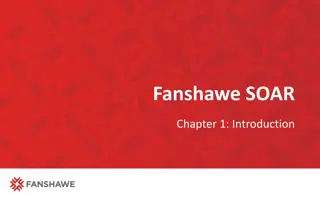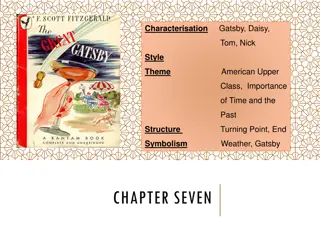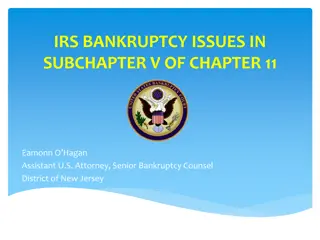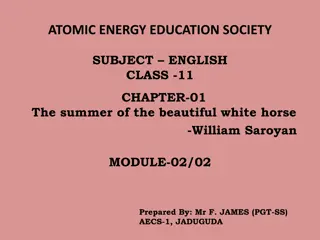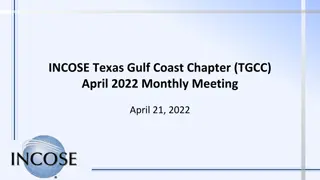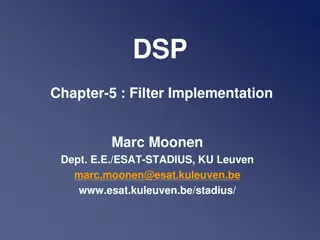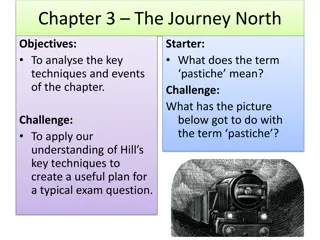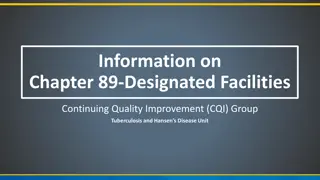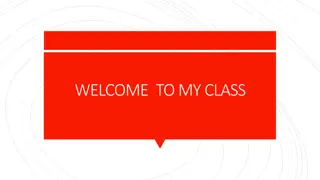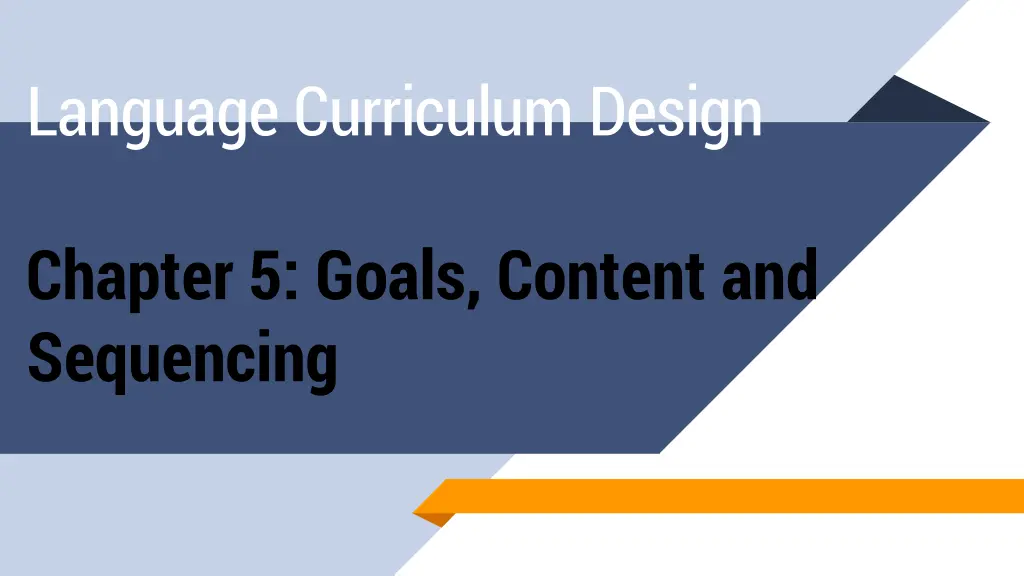
Effective Language Curriculum Design
Learn about setting goals, organizing content, and sequencing in language curriculum design to create effective learning experiences for students. Understand the guidelines for course environment, needs assessment, and stating curriculum outcomes through aims and objectives.
Download Presentation

Please find below an Image/Link to download the presentation.
The content on the website is provided AS IS for your information and personal use only. It may not be sold, licensed, or shared on other websites without obtaining consent from the author. If you encounter any issues during the download, it is possible that the publisher has removed the file from their server.
You are allowed to download the files provided on this website for personal or commercial use, subject to the condition that they are used lawfully. All files are the property of their respective owners.
The content on the website is provided AS IS for your information and personal use only. It may not be sold, licensed, or shared on other websites without obtaining consent from the author.
E N D
Presentation Transcript
Language Curriculum Design Chapter 5: Goals, Content and Sequencing
Goals, Content and Sequencing The aim of this part of the curriculum design process is to make a list of the items to teach in the which they will be taught order in 2
Guidelines for Content and Sequencing of a Course Environment Learners: Learners: The ideas should help learning in the classroom. The ideas should suit the age of the learners. The content should be aligned what learners expect to see in an English course. The sequencing should allow for some learners being absent for some classes. Teachers Teachers The language in the course able to be modeled and comprehended by the teacher. Situation Situation The number of lessons in the course should suit the school term or year. The ideas in the course should increase acceptability usefulness of the course outside the classroom. should be the and 3
Guidelines for Content and Sequencing of a Course NEEDS Lacks Lacks The content should suit the proficiency level of the learners. Wants Wants The content should take account of what learners want. Necessities Necessities The content should be what learners need. 4
Goals and Content What kind of English? At what level of proficiency? purposes? Needs analysis answers these questions And for what The nature of aims and objectives, refer to knowledge, skills, and values. In deciding on goals, planners choose from among alternatives based on assumptions about the role of teaching and of a curriculum. Formulating goals is not, an objective scientific enterprise but a judgment call. 5
Stating curriculum outcomes Aims Aims the terms goal and aim are used interchangeably to refer to a description of the general purposes of a curriculum and objective to refer to a more specific and concrete description of purposes. The purposes of aim statements are: to provide a clear definition of the purposes of a program to provide guidelines for teachers, learners, and materials writers to help provide a focus for instruction to describe important and realizable changes in learning Aims statements reflect the ideology of the curriculum and show how the curriculum will seek to realize it. 6
Objectives AIM: Students will learn how to write effective business letters for use in the hotel and tourism industries In order to give a more precise focus to program goals, aims are often accompanied by statements of more specific purposes. These are known as objectives. An objective refers to a statement of specific changes a program seeks to bring about 7
OBJECTIVES Students will learn how to understand lectures given in English.(A/O?) Students will be able to follow an argument, theme, or thesis of a lecture(A/O?) Objectives describe a learning outcomes. In writing objectives, expressions like will study, will learn about, will prepare students for are avoided because they do not describe the result of learning but gather what students will do during a course. Objectives can be described with phrases like will have, will learn how to, will be able to. 8
OBJECTIVES Aim: Students will learn how to write effective business letters for use in the hotel and tourism industries. Objective: The student can understand and respond to simple questions over the telephone.( consistent with the aim?) Objectives should be precise. Students will know how to use useful conversation expressions. Students will use conversation expressions for greeting people, opening and closing conversations.(which one more precise?) Objectives should be feasible. Students will be able to follow conversations spoken by native speakers. Students will be able to get the gist of short conversations in simple English on topics related to daily life and leisure.(which one is feasible for 60 hours English course?) 9
OBJECTIVES Course aim To prepare students to communicate in English at a basic level for purposes of travel and tourism Course objectives The student will have a reading vocabulary of 300 common words and abbreviations The student will have a listening vocabulary of 300 common words plus numbers up to 100. The student can understand simple written notices, signs, and menus. The student can understand simple questions, statements, greetings, and directions. The student can get the gist of simple conversations in spoken English. The student can pick out unfamiliar phrases from conversations and repeat them for clarification. The student can use in speech 200 common words plus numbers up to 100 for time, quantity, and price. 10
Course planning developing a course rationale describing entry and exit levels choosing course content sequencing course content planning the course content (syllabus and instructional blocks) preparing the scope and sequence plan 11
Course planning: developing a course rationale The course rationale seeks to answer the following questions: Who is this course for? What is the course about? What kind of teaching and learning will take place in the course? This course is designed for working adults who wish to improve their communication skills in English in order to improve their employment prospects. It teaches the basic communication skills needed to communicate in a variety of different work settings. The course seeks to enable participants to recognize their strengths and needs in language learning and to give them the confidence to use English more effectively to achieve their own goals. It also seeks to develop the participants' skills in independent learning outside of the classroom. 12
Course planning: Describing the entry and exit level More detailed descriptions are needed of students' proficiency levels before they enter a program and targeted proficiency levels at the end of it What are the students supposed to achieve at the end of each level( A1,A2,B1,B2,C2 CEFR) in each skills (Writing, reading, listening, speaking and functions) Proficiency scales can be used such as Australian Second Language Proficiency Ratings (ASLPR), ACTFL Proficiency Guidelines, IELTS UCLES/RSA Certificate in Communicative Skills in English 13
Course planning: Choosing course content nature of language, language use, and language learning, what the most essential elements or units of language are, and how these can be organized as an efficient basis for second language learning. For example, a writing course a writing course could potentially be planned around any of the following types of content: grammar (e.g., using the present tense in descriptions) functions (e.g., describing likes and dislikes) topics (e.g., writing about world issues) skills (e.g., developing topic sentences) processes (e.g., using prewriting strategies) texts (e.g.-," writing a business letter) 14
Course planning: Choosing course content content selection will depend on subject matter knowledge, the learners proficiency levels, current views on second language learning and teaching, conventional wisdom, and convenience. Sources of information: available literature on the topic published materials on the topic review of similar courses offered elsewhere review of tests or exams in the area analysis of students' problems consultation with teachers familiar with the topic consultation with specialists in the area 15
Course planning: Determining the scope and sequence Scope Scopeis concerned with the breadth and depth of coverage of items in the course, that is, with the following questions: - What range of content will be covered? - To what extent should each topic be studied? The sequencing The sequencing of content involves deciding which content is needed early in the course and which provides a basis for things that will be learned later. Sequencing may be based on the following criteria. Simple to complex Chronology (i.e writing: (1) brainstorming; (2) drafting; (3) revising; (4) editing.) Need Prerequisite learning Whole to part or part to whole 16
Course Content 1 Units of progression can be used to set targets and paths to those targets. 2 Units of progression can be used to check the adequacy of selection and ordering in a course. 3 Units of progression can be used to monitor and report on learners progress and achievement in the course. 18
Course Content: Vocabulary the first 1,000 words account for 75 per cent of the successive words in a text the second 1,000 words account for 5 per cent of the successive words in a text 570 academic words account for 10 per cent of the successive words in an academic text. vocabulary not in the most frequent 2,000 words or in the academic word list does not deserve teaching effort. (Nation 2001) general service list West (1953), the most frequent 2200 academic words Kuc era and Francis (1967), Academic word list Coxhead (2000) 19
Course Content: Grammar Stage 2 of a course could add the following items. Simple Past Neutral and Habitual Past Perfect from Simple Past Narrative Stem+ing in Free Adjuncts Simple Present Iterative and Future Verb + to + Stem (Stem dominant) Verb + Noun + to + Stem Noun + Preposition + Stem+ing Stem+ed = Adjective in a Noun Group Stem+ing = Adjective in a Noun Group Stem+ing = Noun Can + Stem (immediately and characteristically able) May + Stem (possibility and uncertainty) for Stage 1 of a course 1,500 to 2,000 words over roughly two years of five periods of English per week would consist of the following verbs. George (1963b) Imperative Don t + stem (Imperative) Simple Present Actual and Neutral Verb + to + stem Simple Past Narrative and Actual Past Participle This group of items accounts for 575 of every 1,000 successive verb forms in written English. Noun + to + Stem 20
Want big impact? USE BIG IMAGE 21
THANKS! 22



